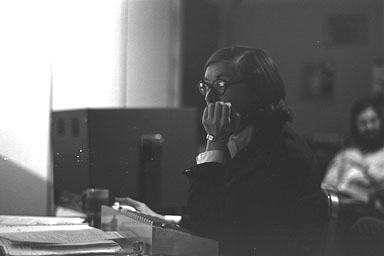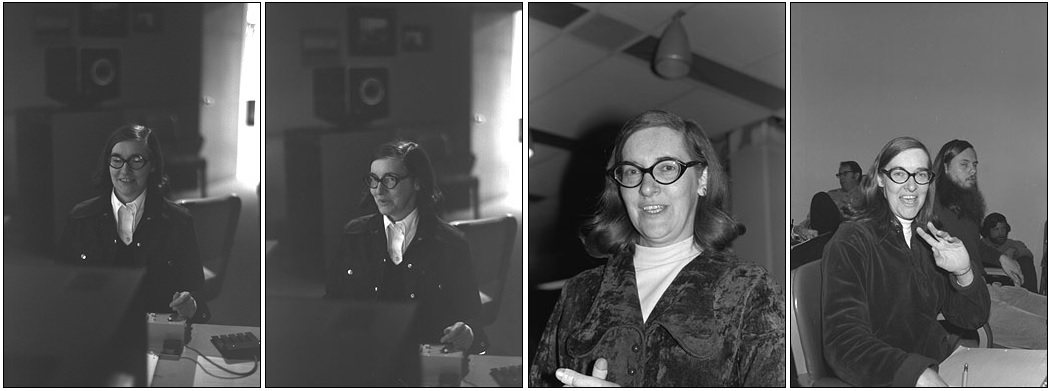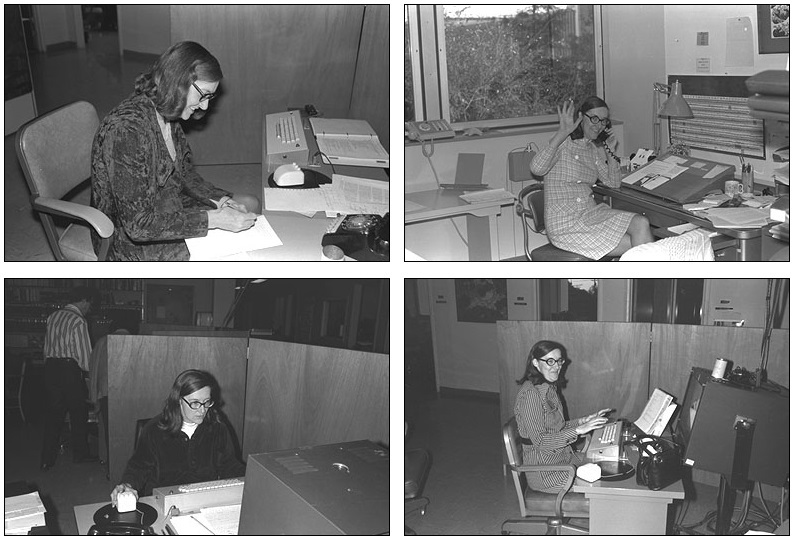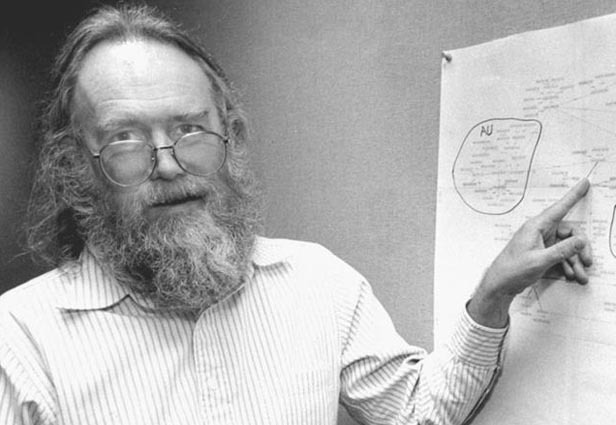2nd of March. "Call Jake." NIC and RFC history
“If you wanted a domain name, you came to Jake.”

There was a time when all the functions of WhoIs, DNS, Google, GoDaddy were performed manually. And she did it the girl nicknamed Jake.
')
- Hello, Jake, I want to register my own domain name symbolic.com, I have a chocolate.

In 1969, Douglas Engelbart attracted a librarian with the modest nickname "Baby" and he invited her to his ARC ( Augmentation Research Center , sponsored by DARPA) research center.
Elizabeth Joslin “Jake” Feinler (born Elizabeth Jocelyn Feinler ) was born in Wheeling, West Virginia and graduated from Western Free State College (she was the first in the family to attend college).
Feinler entered graduate school in biochemistry at Purdue University, but because of her financial situation, she decided to postpone her dissertation for a year or two and went to work in the chemical data service at the American Chemical Society in Columbus, Ohio.
She worked with a large amount of chemical data and became interested in systematization.
In 1960, Feinler found out about a job in California at the Stanford University Research Institute, and her application was accepted. Initially, at the institute she was engaged in collecting data and searching for literature.

The first task for Elizabeth in the Engelbart team was to write a Resource Handbook for the first ARPANET demonstration at the International Computer Communication Conference.
By 1972, when the glorious team was developing the world's first personal computer, the Xerox Alto , it led the working group to create a new Network Information Center (NIC) for ARPANET.
The center gave users information about people, organizations (similar to the “yellow pages”), communication was carried out by regular mail and telephone. Later communication was carried out through e-mail on nodes ARPANET.

Feinler, along with Steve Crocker , Jon Postel , Joyce Reynolds and other members of the Network Working Group (NWG), developed RFC (Request for Comments, Work Offer) - a series of numbered information documents containing technical specifications and standards for ARPANET and then for the Internet.
 The RFC format appeared in 1969 when discussing the draft ARPANET.
The RFC format appeared in 1969 when discussing the draft ARPANET.
RFC 1 was published on April 7, 1969 and was called “Host Software”.
The first RFCs were distributed in printed form on paper in the form of ordinary letters, but since December 1969, when the first segments of the ARPANET were launched, documents began to be distributed electronically.
Most of the early RFCs were created at the University of California, Los Angeles and the Stanford Research Institute.
From 1969 to 1998 the permanent and only RFC editor was John Postel . After his death, the Internet Society ( ISOC ) entrusted the editing and publication of RFCs to the Institute of Information Sciences. University of Southern California.
Essay on the history of RFC for 30 years from 1969 to 1999. is presented in RFC 2555 .
In 1974, Elizabeth with the working group developed a short textual naming of hosts ( Host names on-line ).
In ARPANET, the host owner had to send an email to HOSTSMASTER@SRI-NIC.ARPA to request an address. The HOSTS.TXT file was distributed by the efforts of the NIC employees and was manually installed on each host in the network in order to provide communication (mapping) between all network addresses.
Later, the research team worked on scaling and the functions of the NIC were taken over by the WhoIs and DNS services.
Thanks to Feinler, there is a modern domain name system (.com, .gov, .org, .mil).
In 1989, Feinler went to work at NASA at the Ames Research Center. She retired in 1996 and in 2010 published the history of the NIC . In 2012, she entered the Internet Hall of Fame.
Article about Elizabeth in WIRED
The Network Information Center and its Archives
Elizabeth at Stanford University Hall of Fame
Today is Elizabeth's birthday.
Together with the company Edison we start the spring marathon of publications.
I will try to get to the primary sources of IT-technologies, to understand how they thought and what concepts were in the minds of the pioneers, what they dreamed about, how they saw the world of the future. Why did you think “computer”, “network”, “hypertext”, “intelligence amplifiers”, “collective problem solving system”, what meaning did they put into these concepts, what tools they wanted to achieve a result.
I hope that these materials will serve as an inspiration for those who are wondering how to go “from Zero to Unit” (to create something that had never happened before). I would like IT and “programming” to stop being just “coding for the sake of dough”, and recall that they were conceived as a lever to change themethods of warfare, education, a way of working together, thinking and communication, as an attempt to solve world problems and answer facing humanity. Something like this.
0 March. Seymour papert
March 1. Xerox alto
March 2, "Call Jake." NIC and RFC history
March 3, Grace "Grandma COBOL" Hopper
March 4 Margaret Hamilton: "Guys, I'll send you to the moon"
March 5, Hedy Lamarr. And in the movie naked to play and torpedo the bullet into the enemy
March 7 Gorgeous Six: girls who had a thermonuclear explosion calculated
March 8, "Video Games, I'm your father!"

There was a time when all the functions of WhoIs, DNS, Google, GoDaddy were performed manually. And she did it the girl nicknamed Jake.
')
- Hello, Jake, I want to register my own domain name symbolic.com, I have a chocolate.

In 1969, Douglas Engelbart attracted a librarian with the modest nickname "Baby" and he invited her to his ARC ( Augmentation Research Center , sponsored by DARPA) research center.
Elizabeth Joslin “Jake” Feinler (born Elizabeth Jocelyn Feinler ) was born in Wheeling, West Virginia and graduated from Western Free State College (she was the first in the family to attend college).
Feinler entered graduate school in biochemistry at Purdue University, but because of her financial situation, she decided to postpone her dissertation for a year or two and went to work in the chemical data service at the American Chemical Society in Columbus, Ohio.
She worked with a large amount of chemical data and became interested in systematization.
In 1960, Feinler found out about a job in California at the Stanford University Research Institute, and her application was accepted. Initially, at the institute she was engaged in collecting data and searching for literature.

The first task for Elizabeth in the Engelbart team was to write a Resource Handbook for the first ARPANET demonstration at the International Computer Communication Conference.
Nic
By 1972, when the glorious team was developing the world's first personal computer, the Xerox Alto , it led the working group to create a new Network Information Center (NIC) for ARPANET.
“The NIC looked like prehistoric Google,” says Elizabeth. “People turned to us for any question.”
The center gave users information about people, organizations (similar to the “yellow pages”), communication was carried out by regular mail and telephone. Later communication was carried out through e-mail on nodes ARPANET.

Feinler, along with Steve Crocker , Jon Postel , Joyce Reynolds and other members of the Network Working Group (NWG), developed RFC (Request for Comments, Work Offer) - a series of numbered information documents containing technical specifications and standards for ARPANET and then for the Internet.
RFC
 The RFC format appeared in 1969 when discussing the draft ARPANET.
The RFC format appeared in 1969 when discussing the draft ARPANET.RFC 1 was published on April 7, 1969 and was called “Host Software”.
The first RFCs were distributed in printed form on paper in the form of ordinary letters, but since December 1969, when the first segments of the ARPANET were launched, documents began to be distributed electronically.
Most of the early RFCs were created at the University of California, Los Angeles and the Stanford Research Institute.
From 1969 to 1998 the permanent and only RFC editor was John Postel . After his death, the Internet Society ( ISOC ) entrusted the editing and publication of RFCs to the Institute of Information Sciences. University of Southern California.
Essay on the history of RFC for 30 years from 1969 to 1999. is presented in RFC 2555 .
WhoIs and domain names
In 1974, Elizabeth with the working group developed a short textual naming of hosts ( Host names on-line ).
In ARPANET, the host owner had to send an email to HOSTSMASTER@SRI-NIC.ARPA to request an address. The HOSTS.TXT file was distributed by the efforts of the NIC employees and was manually installed on each host in the network in order to provide communication (mapping) between all network addresses.
Later, the research team worked on scaling and the functions of the NIC were taken over by the WhoIs and DNS services.
Thanks to Feinler, there is a modern domain name system (.com, .gov, .org, .mil).
In 1989, Feinler went to work at NASA at the Ames Research Center. She retired in 1996 and in 2010 published the history of the NIC . In 2012, she entered the Internet Hall of Fame.
Article about Elizabeth in WIRED
The Network Information Center and its Archives
Elizabeth at Stanford University Hall of Fame
Today is Elizabeth's birthday.
Together with the company Edison we start the spring marathon of publications.
I will try to get to the primary sources of IT-technologies, to understand how they thought and what concepts were in the minds of the pioneers, what they dreamed about, how they saw the world of the future. Why did you think “computer”, “network”, “hypertext”, “intelligence amplifiers”, “collective problem solving system”, what meaning did they put into these concepts, what tools they wanted to achieve a result.
I hope that these materials will serve as an inspiration for those who are wondering how to go “from Zero to Unit” (to create something that had never happened before). I would like IT and “programming” to stop being just “coding for the sake of dough”, and recall that they were conceived as a lever to change the
0 March. Seymour papert
March 1. Xerox alto
March 2, "Call Jake." NIC and RFC history
March 3, Grace "Grandma COBOL" Hopper
March 4 Margaret Hamilton: "Guys, I'll send you to the moon"
March 5, Hedy Lamarr. And in the movie naked to play and torpedo the bullet into the enemy
March 7 Gorgeous Six: girls who had a thermonuclear explosion calculated
March 8, "Video Games, I'm your father!"
Source: https://habr.com/ru/post/277913/
All Articles